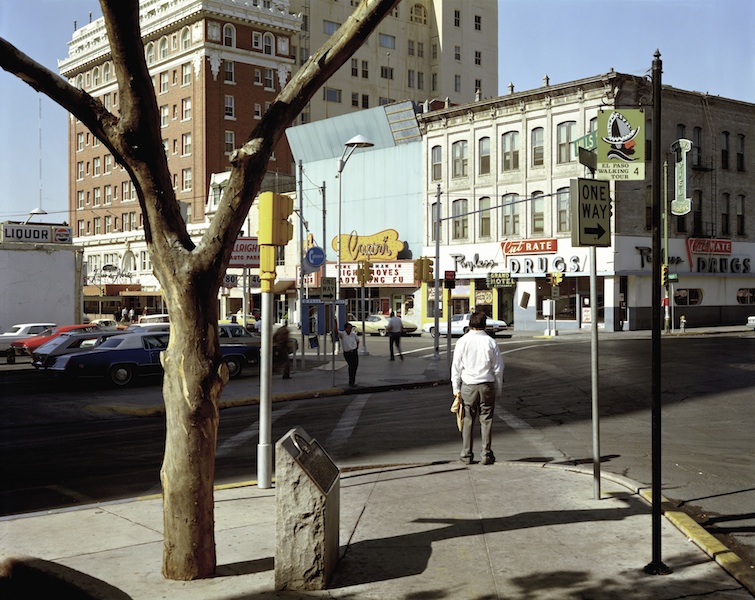
El Paso Street, El Paso, Texas, July 5, 1975 by Stephen Shore. 303 Gallery, New York
A street corner in El Paso in 1975. Nothing is happening. Even the traffic appears to have stopped flowing. The intersection is empty and across the street the sign says, “don’t walk.” A man with a couple of paper bags, in a crumpled shirt and pants too long for his legs, stands there waiting. Another guy leans against a “one way” sign. Maybe he plans to cross. He appears to be in no hurry.
Everything in the picture is totally ordinary. This is a street corner like thousands of others: humdrum and dull. For its photographer, Stephen Shore, though, it was an “uncommon place,” one of many similar scenes that he photographed on roadtrips in the 1970s and published in his photobook Uncommon Places (1982). Later revised and expanded, the hugely influential collection is a classic, a next step after Walker Evans and Robert Frank that helped to define a new way of seeing the American streetscape, now in sharp, detailed color.
This is the work of a rigorously analytical eye. The precision of Shore’s framing, made possible by an 8 x 10-inch camera mounted on a tripod, gives the scene a heightened sense of reality, with everything in the picture equally present and available for scrutiny. Composition is barely mentioned when discussing art photography these days, as though the activity is somehow obvious, facile or negligible. The El Paso scene shows how visual structure can become meaning and, in this regard, the picture is like a painting. As Shore notes in his primer The Nature of Photographs, where he reprints it, the structure “begins with the frame and works inward.” The converging lines of the curbstone concentrate attention on the man. Poised on the brink with his back turned to us, head angled toward the shadowy void of the intersection, he is like a modern-day, down-at-heel, anti-hero version of the concealed, unfathomable figures in paintings by Caspar David Friedrich or Vilhelm Hammershøi.
Sublime is hardly the word here, but viewed so intently the scene seems charged with specialness and significance. A frieze of words begins at one edge with “liquor” and ripples across the center to “drugs” on the other side, the line broken by a cluster of verticals, which add to the density. The one natural element, the brutally leaf-shorn tree splayed like a piece of sculpture, is held in a subtly disturbing exchange with the rough-sided, concrete pillar bearing a commemorative plaque. The everyday is disclosed to be extraordinary.
See all Exposure columns

